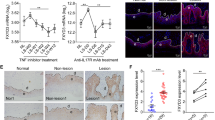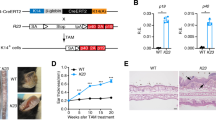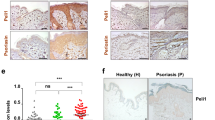Abstract
Here we report that epidermal keratinocytes in psoriatic lesions are characterized by activated Stat3. Transgenic mice with keratinocytes expressing a constitutively active Stat3 (K5.Stat3C mice) develop a skin phenotype either spontaneously, or in response to wounding, that closely resembles psoriasis. Keratinocytes from K5.Stat3C mice show upregulation of several molecules linked to the pathogenesis of psoriasis. In addition, the development of psoriatic lesions in K5.Stat3C mice requires cooperation between Stat3 activation in keratinocytes and activated T cells. Finally, abrogation of Stat3 function by a decoy oligonucleotide inhibits the onset and reverses established psoriatic lesions in K5.Stat3C mice. Thus, targeting Stat3 may be potentially therapeutic in the treatment of psoriasis.
This is a preview of subscription content, access via your institution
Access options
Subscribe to this journal
Receive 12 print issues and online access
$209.00 per year
only $17.42 per issue
Buy this article
- Purchase on Springer Link
- Instant access to full article PDF
Prices may be subject to local taxes which are calculated during checkout





Similar content being viewed by others

References
Gottlieb, A., and Bos, J. Recombinantly engineered human proteins: transforming the treatment of psoriasis. Clin. Immunol. 105, 105–116 (2002).
Valdimarsson, H., Baker, B.S., Jonsdottir, I., Powles, A. & Fry, L. Psoriasis: a T-cell-mediated autoimmune disease induced by streptococcal superantigens? Immunol. Today 16, 145–149 (1995).
Christophers, E. The immunopathology of psoriasis. Int. Arch. Allergy Immunol. 110, 199–206 (1996).
Bos, J.D. & De Rie, M.A. The pathogenesis of psoriasis: immunological facts and speculations. Immunol. Today 20, 40–46 (1999).
Koo, J., Nguyen, Q. & Gambla, C. Advances in psoriasis therapy. Adv. Dermatol. 12, 47–72 (1997).
Eedy, D.J., Burrows, D., Bridges, J.M. & Jones, F.G. Clearance of severe psoriasis after allogenic bone marrow transplantation. BMJ 300, 908 (1990).
Gardembas-Pain, M. et al. Psoriasis after allogeneic bone marrow transplantation. Arch. Dermatol. 126, 1523 (1990).
Lewis, H.M. et al. Restricted T-cell receptor V beta gene usage in the skin of patients with guttate and chronic plaque psoriasis. Br. J. Dermatol. 129, 514–520 (1993).
Leung, D.Y. et al. Evidence for a streptococcal superantigen-driven process in acute guttate psoriasis. J. Clin. Invest. 96, 2106–2112 (1995).
Wrone-Smith, T. & Nickoloff, B.J. Dermal injection of immunocytes induces psoriasis. J. Clin. Invest. 98, 1878–1887 (1996).
Nickoloff, B.J. & Wrone-Smith, T. Injection of pre-psoriatic skin with CD4+ T cells induces psoriasis. Am. J. Pathol. 155, 145–58 (1999).
Gilhar, A., David, M., Ullmann, Y., Berkutski, T. & Kalish, R.S. T-lymphocyte dependence of psoriatic pathology in human psoriatic skin grafted to SCID mice. J. Invest. Dermatol. 109, 283–288 (1997).
Schon, M.P. Animal models of psoriasis—what can we learn from them? J. Invest. Dermatol. 112, 405–410 (1999).
Li, A.G., Wang, D., Feng, X.H. & Wang, X.J. Latent TGFβ1 overexpression in keratinocytes results in a severe psoriasis-like skin disorder. EMBO J. 23, 1770–1781 (2004).
Cook, P.W. et al. Transgenic expression of the human amphiregulin gene induces a psoriasis-like phenotype. J. Clin. Invest. 100, 2286–2294 (1997).
Xia, Y.P. et al. Transgenic delivery of VEGF to mouse skin leads to an inflammatory condition resembling human psoriasis. Blood 102, 161–168 (2003).
Blumberg, H. et al. Interleukin 20: discovery, receptor identification, and role in epidermal function. Cell 104, 9–19 (2001).
Leonard, W.J. & O'Shea, J.J. Jaks and STATs: biological implications. Annu. Rev. Immunol. 16, 293–322 (1998).
Levy, D.E. & Darnell, J.E., Jr. Stats: transcriptional control and biological impact. Nat. Rev. Mol. Cell Biol. 3 (9), 651–662 (2002).
Hirano, T., Ishihara, K. & Hibi, M. Roles of STAT3 in mediating the cell growth, differentiation and survival signals relayed through the IL-6 family of cytokine receptors. Oncogene 19, 2548–2456 (2000).
Turkson, J. & Jove, R. STAT proteins: novel molecular targets for cancer drug discovery. Oncogene 19, 6613–6626 (2000).
Sano, S. et al. Keratinocyte-specific ablation of Stat3 exhibits impaired skin remodeling, but does not affect skin morphogenesis. EMBO J. 18, 4657–4668 (1999).
Sano, S., Takeda, J., Yoshikawa, K. & Itami, S. Tissue regeneration: hair follicle as a model. J. Investig. Dermatol. Symp. Proc. 6, 43–48 (2001).
Takeda, J., Sano, S., Tarutani, M., Umeda, J. & Kondoh, G. Conditional gene targeting and its application in the skin. J. Dermatol. Sci. 23, 147–54 (2000).
Hertle, M.D., Kubler, M.D., Leigh, I.M. & Watt, F.M. Aberrant integrin expression during epidermal wound healing and in psoriatic epidermis. J. Clin. Invest. 89, 1892–1901 (1992).
Ortonne, J.P. Aetiology and pathogenesis of psoriasis. Br. J. Dermatol. 135 Suppl 49, 1–5 (1996).
Piepkorn, M., Pittelkow, M.R. & Cook, P.W. Autocrine regulation of keratinocytes: the emerging role of heparin-binding, epidermal growth factor-related growth factors. J. Invest. Dermatol. 111, 715–721 (1998).
Bromberg, J.F. et al. Stat3 as an oncogene. Cell 98, 295–303 (1999).
Murillas, R. et al. Expression of a dominant negative mutant of epidermal growth factor receptor in the epidermis of transgenic mice elicits striking alterations in hair follicle development and skin structure. EMBO J. 14, 5216–5223 (1995).
Chan, K.S. et al. Epidermal growth factor receptor-mediated activation of Stat3 during multistage skin carcinogenesis. Cancer Res. 64, 2382–2389 (2004).
Chan, K.S. et al. Disruption of Stat3 reveals a critical role in both the initiation and the promotion stages of epithelial carcinogenesis. J. Clin. Invest. 114, 720–728 (2004).
Thewes, M., Stadler, R., Korge, B. & Mischke, D. Normal psoriatic epidermis expression of hyperproliferation-associated keratins. Arch. Dermatol. Res. 283, 465–471 (1991).
Ghadially, R., Reed, J.T. & Elias, P.M. Stratum corneum structure and function correlates with phenotype in psoriasis. J. Invest. Dermatol. 107, 558–564 (1996).
Miller, R.A. The Koebner phenomenon. Int. J. Dermatol. 21, 192–197 (1982).
Detmar, M. et al. Overexpression of vascular permeability factor/vascular endothelial growth factor and its receptors in psoriasis. J. Exp. Med. 180, 1141–1146 (1994).
Leong, P.L. et al. Targeted inhibition of Stat3 with a decoy oligonucleotide abrogates head and neck cancer cell growth. Proc. Natl. Acad. Sci. USA 100, 4138–4143 (2003).
McKenzie, R.C. & Sabin, E. Aberrant signalling and transcription factor activation as an explanation for the defective growth control and differentiation of keratinocytes in psoriasis: a hypothesis. Exp. Dermatol. 12, 337–345 (2003).
Griffiths, C.E., Voorhees, J.J. & Nickoloff, B.J. Characterization of intercellular adhesion molecule-1 and HLA-DR expression in normal and inflamed skin: modulation by recombinant gamma interferon and tumor necrosis factor. J. Am. Acad. Dermatol. 20, 617–629 (1989).
Caldenhoven, E. et al. Activation of the STAT3/acute phase response factor transcription factor by interleukin-5. J. Biol. Chem. 270, 25778–25784 (1995).
Lebwohl, M. et al. A novel targeted T-cell modulator, efalizumab, for plaque psoriasis. N. Engl. J. Med. 349, 2004–2013 (2003).
Krueger, J.G. The immunologic basis for the treatment of psoriasis with new biologic agents. J. Am. Acad. Dermatol. 46, 1–23 (2002).
Lew, W. et al. Psoriasis vulgaris: cutaneous lymphoid tissue supports T-cell activation and “Type 1” inflammatory gene expression. Trends Immunol. 25, 295–305 (2004).
Baker, B.S., Powles, A.V., Valdimarsson, H., & Fry, L. An altered response by psoriatic keratinocytes to gamma interferon. Scand J. Immunol. 28, 735–740 (1988).
Nickoloff, B.J., Mitra, R.S., Elder, J.T., Fisher, G.J., & Voorhees, J.J. Decreased growth inhibition by recombinant γ interferon is associated with increased transforming growth factor-alpha production in keratinocytes cultured from psoriatic lesions. Br. J. Dermatol. 121, 161–174 (1989).
Sato, T., Selleri, C., Young, N.S., & Maciejewski, J.P. Inhibition of interferon regulatory factor-1 expression results in predominance of cell growth stimulatory effects of interferon-γ due to phosphorylation of Stat1 and Stat3. Blood 90, 4749–4758 (1997).
Qing, Y. & Stark, G.R. Alternative activation of STAT1 and STAT3 in response to interferon-gamma. J. Biol. Chem. 279, 41679–41685 (2004).
Acknowledgements
We thank V. Edwards and L. Beltran for editorial assistance. This work was supported by US National Institutes of Health grants CA76520 (J.D.), AR40065 (B.J.N), U01 ES11047, University of Texas M.D. Anderson Cancer Center Support Grant CA16672 and National Institute of Environmental Health Sciences Center Grant ES07784.
Author information
Authors and Affiliations
Corresponding authors
Ethics declarations
Competing interests
The authors declare no competing financial interests.
Supplementary information
Supplementary Fig. 1
Constitutive action of Stat3 in the uninvolved, adjacent epidermis of psoriatic patients. (PDF 725 kb)
Supplementary Fig. 2
Gross skin phenotypes of K5.Stat3C transgenic mice. (PDF 6209 kb)
Supplementary Fig. 3
Persistent psoriatic lesions in K5.Stat3C mice. (PDF 7046 kb)
Supplementary Fig. 4
TPA treatment (twice a week for one month) induced psoriatic skin lesions in K5.Stat3C mice (left panel) with histology (right bottom) identical to human psoriasis. (PDF 5095 kb)
Supplementary Fig. 5
Rapid upregulation of epidermal ICAM-1 by tape-stripping is Stat3-dependent. (PDF 802 kb)
Rights and permissions
About this article
Cite this article
Sano, S., Chan, K., Carbajal, S. et al. Stat3 links activated keratinocytes and immunocytes required for development of psoriasis in a novel transgenic mouse model. Nat Med 11, 43–49 (2005). https://doi.org/10.1038/nm1162
Received:
Accepted:
Published:
Issue Date:
DOI: https://doi.org/10.1038/nm1162
This article is cited by
-
Tenascin C+ papillary fibroblasts facilitate neuro-immune interaction in a mouse model of psoriasis
Nature Communications (2023)
-
A multifunctional composite hydrogel as an intrinsic and extrinsic coregulator for enhanced therapeutic efficacy for psoriasis
Journal of Nanobiotechnology (2022)
-
Mupirocin blocks imiquimod-induced psoriasis-like skin lesion by inhibiting epidermal isoleucyl-tRNA synthetase
Cell Communication and Signaling (2022)
-
Cell death-induced immunogenicity enhances chemoimmunotherapeutic response by converting immune-excluded into T-cell inflamed bladder tumors
Nature Communications (2022)
-
Alpha-7 nicotinic acetylcholine receptor agonist alleviates psoriasis-like inflammation through inhibition of the STAT3 and NF-κB signaling pathway
Cell Death Discovery (2022)


